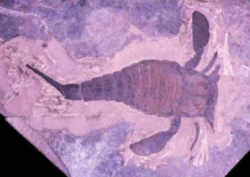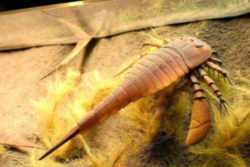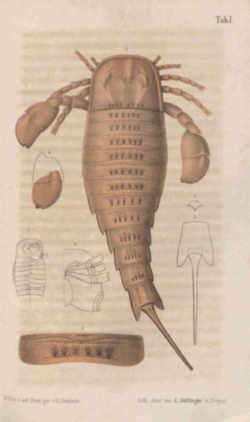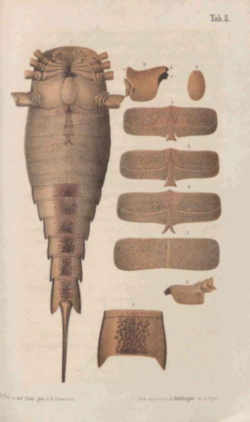New York State Fossil
Sea Scorpion

(Eurypterus remipes)
Adopted in 1984.
Although Sea Scorpion, (Eurypterus remipes) is not as common as some other New York eurypterids, its distinction as the first sea scorpion, Eurypterus remipes, ever discovered led to its adoption as New York state fossil in 1984.
The most common Eurypterus species. Has four raised scales at the posterior margin of the carapace. Appendages I to IV has two spines on each podomere. Postabdomen has small epimera. Pretelson has small, semiangular epimera with imbricate scale ornamentation at the margins. The telson has serrated margins along most of its length. It is very similar to E. lacustris and can often only be distinguished by the position of the eyes. The specific name means "oar-foot", from Latin rēmus (oar) and pes (foot). Found in New York and Ontario. Eurypterus Remipes, is an extinct relative of the modern king crab and sea scorpion.
New York State Fossil: Sea Scorpion

Eurypterus is
an extinct genus of sea scorpions. They existed during the Silurian Period, from around 432 to 418 million years ago.
There are fifteen species belonging to the genus Eurypterus, the most common of which is Eurypterus remipes, the first eurypterid fossil discovered
and the state fossil of New York.
Members of Eurypterus averaged at about 5 to 9 in (13 to 23 cm) in length, but the largest individual discovered was 1.3 m (4.3 ft) long. They all
possessed spine-bearing appendages and a large paddle they used for swimming. They were generalist species, equally likely to engage in predation or
scavenging.
During the Silurian Age (over 400 million years ago), Eurypterus Remipes crawled along the bottom of the shallow, brackish sea that covered much of New York, extending from Buffalo to Schenectady and south to Poughkeepsie, roughly along the route of the New York Thruway.
The first animal ever to have moved from water to land also knew how to get out of its shell.
- Type: Arthropod
- Size: 1-2m long
- Diet: Carnivore
- Predators: Each other, larger eurypterids and giant orthocones
- Lived: Ordovician, 460-445 million years ago.
The first fossil of Eurypterus was found in 1818 by S. L. Mitchill, a fossil collector. It was recovered from the Bertie Formation of New York (near Westmoreland, Oneida County). Mitchill interpreted the appendages on the carapace as barbels arising from the mouth. He consequently identified the fossil as a catfish of the genus Silurus.
It was only after seven years, in 1825, that the American zoologist James Ellsworth De Kay identified the fossil correctly as an arthropod. He named
it Eurypterus remipes and established the genus Eurypterus in the process. The name means "wide wing" or "broad paddle",
referring to the swimming legs.
EURYPTERUS REMIPES-NEW YORK
SOURCE: All text below is taken directly from the magazine Fossil News: The Journal of Avocational Paleontology, September 2000.
 During the Silurian period of 440-395
million years ago the world was going through a period of immense change. Plants and algae first began to colonize the cold, barren land. Insects soon
followed. Before long a massive ecological system had already formed on the newly settled land. The Silurian seas were enduring changes, too. Coral
reefs spread across the globe. Although less abundant than earlier in their history, trilobites continued to adapt and live on the ocean floors. And,
terrorizing the Silurian seas was a new and interesting type of predator-a sea scorpion.
During the Silurian period of 440-395
million years ago the world was going through a period of immense change. Plants and algae first began to colonize the cold, barren land. Insects soon
followed. Before long a massive ecological system had already formed on the newly settled land. The Silurian seas were enduring changes, too. Coral
reefs spread across the globe. Although less abundant than earlier in their history, trilobites continued to adapt and live on the ocean floors. And,
terrorizing the Silurian seas was a new and interesting type of predator-a sea scorpion.
We all know what a scorpion is, but what about a sea scorpion? These Silurian and Devonian predators, which are known to science as eurypterids, ranged
from a mere 10 centimeters to an immense six feet, making them the largest arthropods to have ever lived. They were distantly related to spiders, land
scorpions, and horseshoe crabs, and somewhat resembled a large, oversized lobster. The body of the sea scorpion was segmented, as with all arthropods,
and was divided into two basic sections. The first division, the prosoma, contained the compound eyes, mouth, and six pairs of leg-like appendages,
the first of which sported large, grasping pinchers. The second division of the sea scorpion body, the opisthosoma, included the tail segments and
the telson, the triangular flap of armor extending from the tail.
 In life the sea scorpion was likely
a bottom dweller, crawling along the ocean floor searching for food, which probably included trilobites, cephalopods, or whatever its pinchers could
grab. Fossils of these eurypterids have been found in rock layers that were formed in brackish or freshwater environments, although some of the earliest
sea scorpions may have lived in the ocean. There is even the possibility that some eurypterids may have lived part of their life on land.
In life the sea scorpion was likely
a bottom dweller, crawling along the ocean floor searching for food, which probably included trilobites, cephalopods, or whatever its pinchers could
grab. Fossils of these eurypterids have been found in rock layers that were formed in brackish or freshwater environments, although some of the earliest
sea scorpions may have lived in the ocean. There is even the possibility that some eurypterids may have lived part of their life on land.
The first sea scorpion fossil was discovered in 1818 by fossil hunter S.L. Mitchell in Silurian rocks of New York State. He initially mistook the creature
as a catfish, and it was not until 1825 that eurypterids were recognized as a group of arthropods. Today eurypterid fossils are abundant in the Bertie
Dolostone, a Silurian limestone layer that extends from Buffalo, New York through Herkimer County, roughly the route of the New York Thruway. These
rocks were formed between 415-400 million years ago, when a certain eurypterid, Eurypterus remipes, was terrorizing the shallow, tropical
sea that once covered much of present day New York.
Former New York State Paleontologist Donald Fisher campaigned for the adoption of this species of sea scorpion to be designated as New York's official
state fossil, and in 1984 governor Mario Cuomo signed a bill making Fisher's dream a reality. And, millions of fossils of Eurypterus remipes
remain in the dolostone, making the dreams of fossil hunters, rockhounds, and paleontologists alike a reality, too.
The New York Consolidated Laws
The law designating the Sea Scorpion as the official New York state fossil is found in the New York Consolidated Laws, State Law, Article 6, Section 83
STATE LAWS
ARTICLE 6 - ARMS AND GREAT SEAL OF STATE.
SECTION 83.
§ 83. State fossil. The Eurypterus remipes shall be the official fossil of the state of New York.
Taxonomic Hierarchy: Sea Scorpion
Kingdom: Animalia
Phylum: Arthropoda
Class: Merostomata
Order: Eurypterida
Superfamily: Eurypteroidea
Family: Eurypteridae
Genus: Eurypterus
Species: Eurypterus remipes

Some states that lack a "state fossil" have nevertheless singled out a fossil for formal designation such as a state dinosaur, rock, gem or stone.







